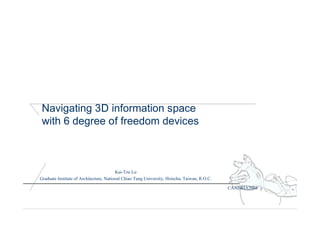Navigating 3D information space with 6 degree of freedom devices
- 1. CAADRIA2004 Navigating 3D information space with 6 degree of freedom devices Kai-Tzu Lu Graduate Institute of Architecture, National Chiao Tung University, Hsinchu, Taiwan, R.O.C.
- 2. CAADRIA2004 Motivation  The purpose of this research is to identify how to intuitively operate 6 DOF Input Devices for interactive data storage in 3D virtual environments.  It is under the condition that the role of the computer is to simulate the way people sense the real space, so  users may instinctively utilize this simple device to explore the possibility of data recurrence and reorganization, and  designers may receive timely inspiration in the process of architectural design.
- 4. CAADRIA2004 Related work of 6DOF Input Devices  Force feedback  Hand-sensor  Computer Vision
- 5. CAADRIA2004 Research Question  These complex systems are for multi-functional operation. They are too intricate for simple navigation of 3D VES information system. Function 1 Function 2 Function 3 Function 4
- 6. CAADRIA2004 Objective  This research studies the way people navigate 3D VES information system and the actual spatial experience.  I then develop a 6 DOF device for implementing basic navigational function with easy operation and compatibility with different interfaces.
- 7. CAADRIA2004 The Properties of 6 DOF Devices  To provide immediately feedback  To manipulate 3D virtual information Directly X Y Z θ ø φ
- 8. CAADRIA2004 Methodology  Keyboard and mouse control  MUSE as an example  Gesture analysis for interacting with 3D information space  Implementing a 6 DOF device  Demonstration of its usability
- 9. CAADRIA2004 Keyboard and Mouse Controls  Navigation in MUSE :  Toggle mouse-look mode: SHIFT-key’ rotategravitatewalk decisionzigzig pickjumpWalk RollDownBackward Shift+ Direction [F][S] O.K.RightBasicLeft Mouse Click[D][A] selectionUpForward Mouse Click[R][W]
- 10. CAADRIA2004 Gesture analysis for interacting with 3D information space  The actual usage of a 6 DOF device based on the gesture analysis RotateGravitateWalk decisionzigzig pickjumpWalk RollDownBackward Shift+ Direction [F][S] O.K.RightBasicLeft Mouse Click[D][A] selectionUpForward Mouse Click[R][W] Standgravitatewalk decisionzigzig pickjumpWalk stopDownBackward O.K.RightBasicLeft selectionUpForward
- 11. CAADRIA2004 Implementing a 6 DOF device rotategravitatewalk decisionzigzig pickjumpWalk RollDownBackward O.K.RightBasicLeft selectionUpForward
- 12. CAADRIA2004 Implementing a 6 DOF device  Building up a 3D virtual space using MUSE environment  A device implemented based on the gesture analysis and reviews 1. 2. 3. 4. 5. 6. 7. 8. 1. 2. 3. 4. 5. 6. 7. 8.
- 14. CAADRIA2004 Conclusion  During the implementation testing of 6DOF input device, the hardware itself tends to fix the posture and wear people out so they are not able to browse for extended period of time.  Spiral-type browsing offers a new visual experience that helps us rethink whether in the 3D browsing environment there can be operational modes other than simulating the way human beings walk to give users different experiences in the visualized information-browsing space.
- 15. CAADRIA2004 Future Works  A 6DOF device will provide some empirical and real data for analysis of human navigation behaviours.  This can be explored along dynamic interactive spatial experience.  With the device, extended controls can be defined.









![CAADRIA2004
Keyboard and Mouse Controls
 Navigation in MUSE :
 Toggle mouse-look mode: SHIFT-key’
rotategravitatewalk
decisionzigzig
pickjumpWalk
RollDownBackward
Shift+
Direction
[F][S]
O.K.RightBasicLeft
Mouse
Click[D][A]
selectionUpForward
Mouse
Click[R][W]](https://image.slidesharecdn.com/caadria2004-120911051239-phpapp02/85/Navigating-3D-information-space-with-6-degree-of-freedom-devices-9-320.jpg)
![CAADRIA2004
Gesture analysis for interacting with 3D information
space
 The actual usage of a 6 DOF device based on the gesture analysis
RotateGravitateWalk
decisionzigzig
pickjumpWalk
RollDownBackward
Shift+
Direction
[F][S]
O.K.RightBasicLeft
Mouse
Click[D][A]
selectionUpForward
Mouse
Click[R][W]
Standgravitatewalk
decisionzigzig
pickjumpWalk
stopDownBackward
O.K.RightBasicLeft
selectionUpForward](https://image.slidesharecdn.com/caadria2004-120911051239-phpapp02/85/Navigating-3D-information-space-with-6-degree-of-freedom-devices-10-320.jpg)





